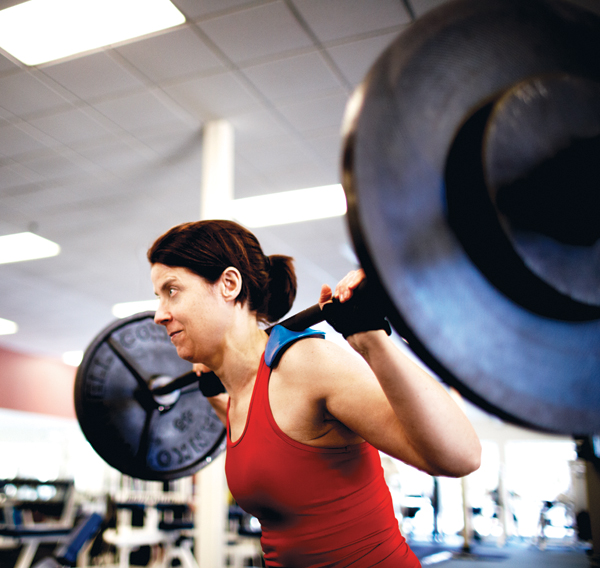Dumbbelles: Overcoming the Stigma of Women Who Weightlift

Photo by Jonathan Kozowyk
A year ago this month, my new personal trainer led me up the stairs to the second floor of my gym in Concord, the Thoreau Club. I was nervous. It’s an upscale suburban gym—the type that’s filled with Bosu balls and treadmills—and until that point I had mostly avoided the upstairs room, because it’s loaded with racked weights, benches, and weight machines. I hadn’t come to the gym to add muscle—I had come to shed pounds. Besides, the weight room was always filled with grunting men. My trainer, Lynda Wright, smiled as we looked into the room. “Okay,” she said. “Let’s see where you are.”
Surrounded by floor-to-ceiling mirrors, I sighed. I’d already given her the abbreviated version over the phone—that I’d played college sports and stayed in shape right up to my first pregnancy, in 2003, but that after two kids, the baby weight remained. I wasn’t exercising enough, I was eating more Goldfish crackers than salads, and I’d started a medication with the unfortunate side effect of increasing appetite while decreasing metabolism. “Look at me,” I told her. “It’s pretty clear where I am.” I tugged the sleeves of my blue T-shirt, trying to cover up my arm flab.
Frankly, I was confused about what we were doing in a room of free weights. My goal was to lose weight and get back in shape. I’d been expecting a routine made up of the treadmill, the elliptical, and maybe a couple of weight machines. Why were we up here on the second floor?
Still, I went along, lying back on a weight bench, happy to be in a position that diminished the size of my gut. Wright put two silver 15-pound dumbbells in my hands and showed me how to do a simple press, bringing my hands almost together as I straightened my arms above my chest.
By the time I got to the third set, pushing those 15-pounders up took everything I had. I’d barely managed six repetitions before my arms started shaking and Lynda took the dumbbells. I sat up and tried to breathe. “That was great,” she said. She nodded over to the next rack, the one that held the real weights—the ones that men with no necks use for their bicep curls. “Pretty soon you’ll be ready for those.”
Those weights looked huge. Visions of she-male bodybuilder freaks from 1990s Lifetime specials flashed through my head. I was here to drop some pounds and firm up—not become a female Arnold.
Wright smiled again. “You just wait and see.”
Despite my misgivings, I continued returning to the gym and lifting. By April, just two months later, I’d graduated from the silver 15-pound dumbbells up to the 25-pounders. Real weights. In addition to the lifting, I had improved my diet and was doing some cardio sessions. I’d lost close to 20 pounds. I’d gotten in good shape before by eating well and doing cardio, but the weightlifting made an enormous difference. I was feeling powerful—and I loved it.
However, I was also feeling like a freak show. Whenever I was lifting, I could feel the stares at my back. The men, so unused to finding a woman among them—let alone one hoisting heavy weights—were outright astonished. The women passing through to the second-floor yoga room simply looked uneasy, as though put off by the sight of a woman doing something so unfeminine. It was embarrassing. It took all I had to keep returning to the gym.
But I did, because it turns out that the Centers for Disease Control and Prevention (CDC) recommends lifting heavy weights as part of a healthy lifestyle. Research shows that regular strength training results in increased bone density, lower blood pressure, and a longer lifespan. No wonder CDC guidelines call for adults to each week do two or more muscle-strengthening workouts—which means lifting a load that taps you out after 8 to 12 repetitions. (Whatever your weightlifting approach—heavy or light—studies show that you need to lift until extreme fatigue to get the benefits.) And yet even though women make up more than half of gym-goers, the CDC’s 2011 National Health Interview Study reports that just 20 percent of them strength-train that minimum of two times per week.
Why? What’s pushing all these cardio queens away from the weight room?
At least some of the problem is a simple lack of knowledge about the benefits of lifting. “A lot of people have the thought process that if they want to lose pounds, then they shouldn’t be lifting heavy weights,” Lynda Wright says. “That’s just not true.” In fact, strength training increases metabolism even more than cardio workouts. “The more muscle mass you have, the more calories you burn at rest,” Wright says. That leads to fat loss and an increased potential for overall weight loss. A Penn State study found that people who lift weights lose six more pounds of fat than those who don’t.
But it’s my feeling that the lack of education about weightlifting pales in comparison to the way American society looks down on women who lift weights. When it comes to females working out, there’s a glaring and insulting double standard—women should be toned but never jacked. No wonder, then, that women (and men) tend to treat cardiovascular exercise—the treadmill, the stationary bike, the elliptical machine—as the holy grail of female fitness. The fairer sex can sweat it out in hot yoga, but must never lose the softness, the femininity.